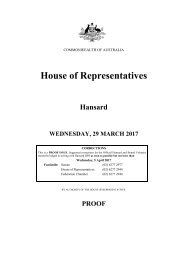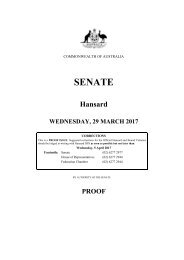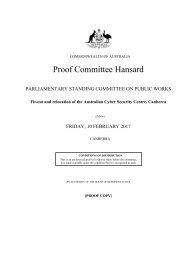SENATE
2f60l5b
2f60l5b
Create successful ePaper yourself
Turn your PDF publications into a flip-book with our unique Google optimized e-Paper software.
Friday, 21 October 2016 Senate Page 31<br />
responsibilities and other matters. So it is about understanding that story, encouraging Indigenous women to<br />
participate if that is what they are keen to do and if it is the right time in their lives, and also encouraging them to<br />
complete their education.<br />
Senator KAKOSCHKE-MOORE: Does the department work with the Office for Women?<br />
Ms Hefren-Webb: We work very closely with the Office for Women on their gender strategy. We have done<br />
some really good work with them on understanding trends in the labour force, trends in caring, trends in<br />
parenting, Indigenous women's ownership of business, entrepreneurship and also Indigenous women's<br />
accumulation of retirement incomes.<br />
Senator KAKOSCHKE-MOORE: If you cannot tell me now, you can take this on notice: are there are any<br />
specific projects that are on foot at the moment that you could give me a little bit more information on?<br />
Mr Eccles: I will start at the broad end and then maybe Ms Anderson can go into a little bit more detail. Our<br />
employment programs are one of the cornerstones of the work that we do. It is based on the view that a job is so<br />
fundamental to someone's wellbeing and aspirations—looking after family and other things. We have a number of<br />
employment programs that really are depending on an individual's personal circumstance across all our programs.<br />
We have some like the VTEC program where we work with people with multiple barriers to employment and<br />
give them training and then place them into jobs. We work with the VTEC—<br />
Senator KAKOSCHKE-MOORE: Can you tell me how many participants there have been in that specific<br />
program?<br />
Mr Eccles: Yes, sure. We have just hit the milestone of 5,000 permanent jobs arising from the VTEC<br />
programs. All in all, across all of our programs, since September 2013, there have been over 44,000 employment<br />
instances or commencements. We do not have the number who are women but we will certainly endeavour to<br />
take that on notice.<br />
Senator KAKOSCHKE-MOORE: Are there plans to roll out VTEC in Ceduna?<br />
Mr Eccles: Not at this stage. We do have other programs in Ceduna. One thing we could do on notice is to get<br />
you a fairly detailed outline of the Ceduna employment programs that we have in place. There are quite a few<br />
things we are doing in that area.<br />
Senator KAKOSCHKE-MOORE: The feedback I had while I was there was that VTEC might be a goer<br />
there. So perhaps this is some feedback for you, but I would appreciate if on notice or during a briefing we can<br />
have a further discussion.<br />
Senator Scullion: A lot of people say: 'Oh VTEC, that goes well. Look at all the jobs they have created.' But<br />
if you have a VTEC in a place, it does not affect the jobs that are actually available, and it is predicated on finding<br />
a job first. So somebody has to put their hand up with a real position, somewhere, and then we find someone with<br />
a trade for the position. But in places like Ceduna, one of the challenges is that there just aren't any jobs. I would<br />
love to have more jobs. Sometimes it is a critical mass issue. I think it is a process that we should move more and<br />
more to rather than just a VTEC model. Right across the board, we should be trying to identify a job and then put<br />
someone in it. The issue around VTEC in Ceduna is probably more about critical mass and the availability of jobs<br />
than the model we use.<br />
Senator KAKOSCHKE-MOORE: My final question is in relation to the Women's Safety Package. In<br />
particular, I understand that $100 million were allocated to reduce Indigenous family and domestic violence. Are<br />
you able to provide me with a breakdown of how that funding is being spent?<br />
Ms Hefren-Webb: The $100 million related to the whole package. I might pass to my colleague, Tarja<br />
Saastamoinen, to answer the details.<br />
Ms Saastamoinen: Of the $100 million in the Women's Safety Package, $21 million has been set aside for<br />
PM&C to manage, in particular, Indigenous initiatives. It is funding a number of different types of initiatives for<br />
women and to support women's safety in communities. It includes things like support services for women in<br />
communities who are affected by violence, it includes other types of services around addressing attitudes and<br />
behaviours toward women and girls in communities and it—<br />
Ms Hefren-Webb: I will also add that it funds some improved police responses to domestic violence in<br />
Queensland and the Northern Territory, some activities to reduce the likelihood of perpetrators reoffending and<br />
some training for nurses who are delivering services as part of the Australian Nurse-Family Partnership Program.<br />
Senator KAKOSCHKE-MOORE: With regard to training for police and nurses, you mentioned that the<br />
funding has been allocated to police in Queensland and in the Northern Territory. Will it be rolled out to other<br />
states?<br />
FINANCE AND PUBLIC ADMINISTRATION LEGISLATION COMMITTEE















